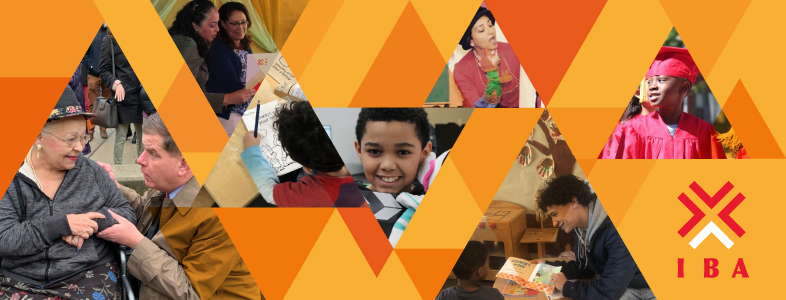
- On January 29, 2021
- In
Program Impact Outlook for 2021
As we look forward to all we will accomplish in 2021, we thought it would be a
great time to check-in with our Chief Program Officer, Rafael Medina, to hear
what he’s most excited about in 2021:
Q: What can you share with us about your goals for programming this year?
A: Our programming goals are always to serve our community in the best ways
we can and achieve IBA’s theory of change. Although our goals always come
from our strong foundational mission, each year they adapt, grow, and evolve.
As long there is poverty, inequality, and injustice, our goals will work towards
shifting the narratives, creating opportunities, and supporting our families to
help them escape the cycle of poverty through upward social and economic
mobility opportunities. From a programmatic perspective, 2021 outcomes and
outputs are better targeted and more tangible. These new targeted outcomes
and outputs, which are called points of accountability, are the culmination of a
multi-year process. We are focused, the Board is happy, our constituents are
exited, and the team is strong. This is going to be an exciting year for
programs.
Q: Can you describe IBA’s theory of change?
A: We think of community development as addressing inequities by helping our
community achieve upward social and economic mobility. This is an inspiring
statement that nurtures our work to address systematic barriers seen in well-
documented research around poverty. Our programs answer the following
questions: Who will be impacted? How we will archive it? What is the impact? and
How are we measuring it? Those questions cover our four categories of impact:
(1) Housing & economic stability, (2) Education, (3) Health & wellness, and (4)
Civic engagement & leadership. Each category is driven by points of
accountability. Through the work in these four categories, families will
experience upward social and economic mobility, ultimately experiencing
greater equity. This is our road map and theory of change.
What is also fascinating and unique about our work, and how we navigate the
beautiful complexities in our big goals, is our culturally-responsive approach.
We are a Latinx organization, with strong Puerto Rican roots, that serves
primarily Latinx individuals. This identity is core to everything we do here at
IBA. All this comes full circle, with our Arts Program. We are recognized as
Boston’s Latino Arts Hub. A testament to our art and cultural work for more
than half of century in the City of Boston.
Q: How do you measure the impact programs have?
A: We have been working over the last 8 years (and counting) to create a strong
data culture throughout our organization. Though this effort, we’ve worked to
address how we measure what our programs do and how we speak about our
impact. We have a strong foundation of basics in place: a robust database and a
culture that values weekly, monthly, and quarterly discussions about our data
measurements. Without the dedication, creativity and commitment from our
data manager, program directors, and coordinators, reliable data would become
and abstract concept and a bumpy journey. Exactly what we moved away from.
Under our four categories of impact: (1) Housing & economic stability, (2)
Education, (3) Health & wellness, and (4) Civic engagement & leadership there
are points of accountability.
Each point of accountability, has a target number and percent, and is driven by
activities, interventions, and management. That’s where the magic, the impact,
happens.
Here are some examples of the points of accountability from our categories: %
Participants living in affordable, safe, high-quality housing. % Participants
building/increasing credit and banking. % Participants with access to affordable,
healthy food. % Participants engaged in Latinx arts and culture. % Participants
registered to vote, as well as % voting in both local and nationwide elections.
All these points aim to answer the WHY. Why is important to disrupt poverty?
Q: What can you tell us about IBA’s plans for 2021?
A: Our points of accountability are robust and interconnected and touch
different areas of community development. In our work, is not realistic to
assume that we are only going to only stick to our points of accountability.
Community development work is always “alive”, constantly adjusting and
recalibrating to policy changes, new trends, public health, environment,
demographic shifts, the economy, political climate, changes in technology, to
mentioned few. That makes our day-to-day exiting and also challenging. We
want to keep up with the changing environment and keep building upon our
work. The nature of our work means that we will always need to keep room to
add new, challenging, and exiting things.
Let’s take for example Covid-19, a common denominator of change across the
planet this past year. We, in our capacity and scope, did everything we could to
continue achieving our mission, commitments, and goals throughout the
pandemic. These unforeseen events always bring added elements and additions
to our work, but we always start with the strong foundation of our programs,
and the important “Why”.
In addition, there two key ingredients that make us effective in our
programmatic approach: organizational buy in and our communication
strategies outlined in our strategic plan. With buy-in to common goals and
communication strategies our organization is able to mitigate these unforeseen
challenges and adjust our work as needed. I predict in 2021, that we will see
some of these adaptations (remote and virtual services are here to stay) but in
the end, our work remains the same and built upon the unending commitment
we have to the families we serve through our programs and affordable housing
portfolio.
...